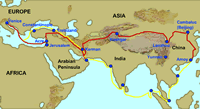On the Road with Marco Polo: From Hormuz to Kashgar
Marco Polo and his father and uncle had traveled all the way from Venice to
Hormuz, a port on the Persian Gulf. From here they had hoped to travel by ship
to China. But they were so concerned about the seaworthiness of the ships they
found there that they changed their plans and decided instead to follow a series
of trade routes across Asia to China. They set out, traveling northeast through
Persia until they entered Afghanistan.
Student Activity:
Afghanistan is a very rugged country. Find out about its geography by accessing
the following website
Since very early times, most Afghans have been nomadic herders of cattle and
camels. However, there are some craftsmen and merchants among them.
Guiding Questions for Discussion:
- What difficulties might the Polos have encountered in traveling across the
harsh terrain of Afghanistan?
- What might the living conditions in this region have been like?
- How did most of the local people make a living?
The Polos were now traveling along one of the main routes of the Silk Road.
This network of trade routes had been used for centuries by merchants carrying
products between China and the West.
A thin strip of Afghanistan protrudes eastward into China. This is where the
Polos encountered a major challenge: the towering Pamir Mountains.
- Access Elevation
map of Afghanistan available through Ask
Asia. Using your cursor, point out the strip of Afghanistan that extends
eastward into China. You might also wish to indicate this area on the large
world map in the classroom.
- Access Topography
of western Asia available through Asia
Source. This is a graphic representation of the mountains of Central Asia.
Explain that the darker shades of brown indicate mountains with the highest
elevations, while white indicates a snowcap. This region has some of the world's
tallest mountains. (Mt. Everest is nearby.) Point out the Pamirs.
- You can view an image of the rugged peaks of the Pamirs by accessing Weekly
wallpaper available through Xpeditions. Click on Panorama of the Pamirs; then click your
monitor size to download the image; maximize the image on the screen.
Notice the horses grazing in the valley in the foreground. Since ancient times,
the Pamir region (which extends to the Ferghana valley to the north) has been
famous for beautiful, long-legged horses. The Chinese acquired thousands of
them for their imperial armies.
Guiding Questions for Discussion:
- What is the terrain like in Afghanistan?
- What are some of the challenges in traveling across Afghanistan and into
China?
Once they made it across the Pamirs, the Polos arrived in Kashgar, an important
trading center. This is where merchant caravans could acquire fresh pack animals,
water, and food supplies. This bustling town must have been a welcome sight
after the rigorous trek through the deserts and mountains!
Student Activity:
Carefully study the photographs of modern Kashgar, still a trading center,
at the following websites (available through Asia
Source):
Guiding Questions for Discussion:
- Why was Kashgar an important stop along the Silk Road?
- What sorts of products could be obtained there?
- What are some of the products sold in Kashgar today?
Assessment:
Instruct the students, working in pairs, to fill out the chart
Afghanistan and Bordering
China in PDF format. Then explain that Marco Polo was a very observant young
man, who most likely kept a detailed diary of his travels. Have each student
assume the role of Marco Polo and write an entry (or more) in his diary, describing
the highlights of the journey from Hormuz to Kashgar.
Selected EDSITEment Websites
Asia Source
Ask Asia
Internet Public Library
Xpeditions
Standards Alignment
View your state’s standards
|





